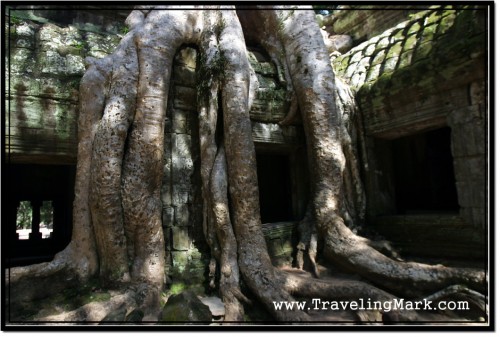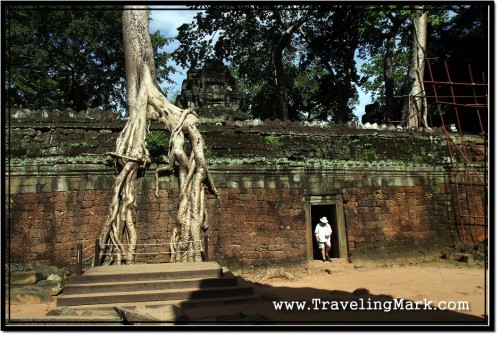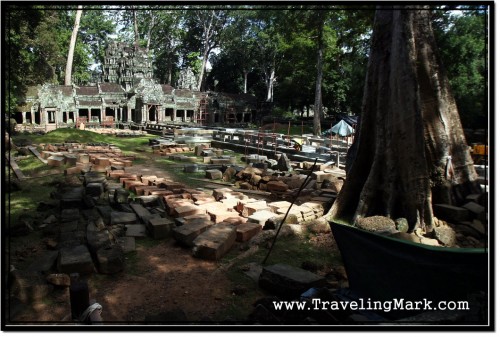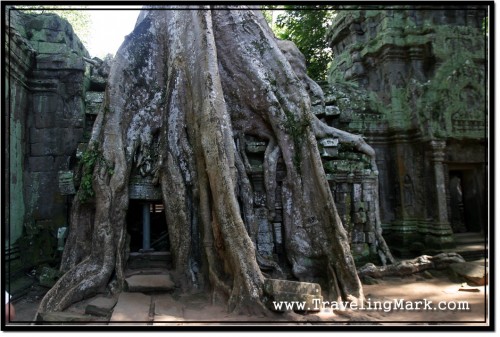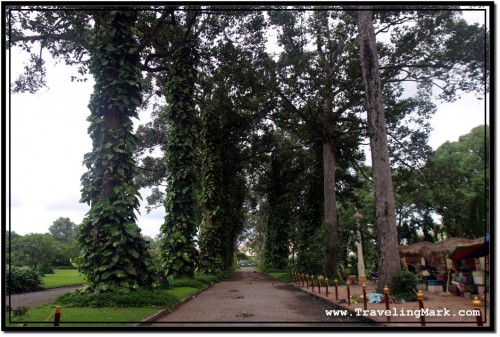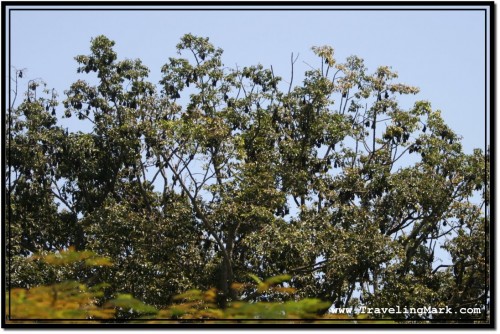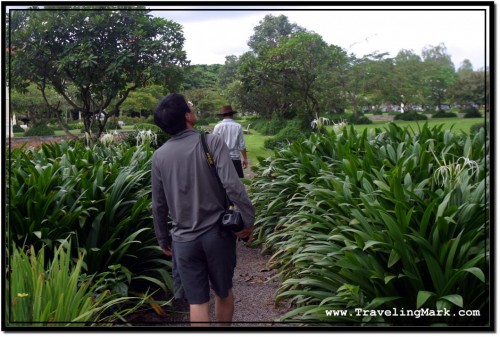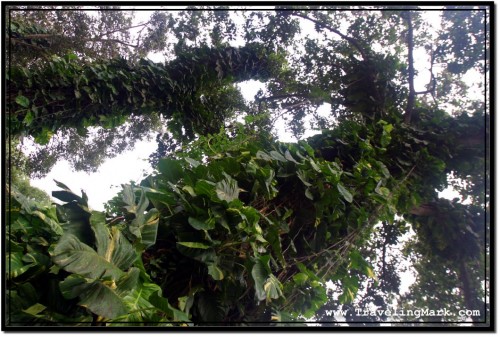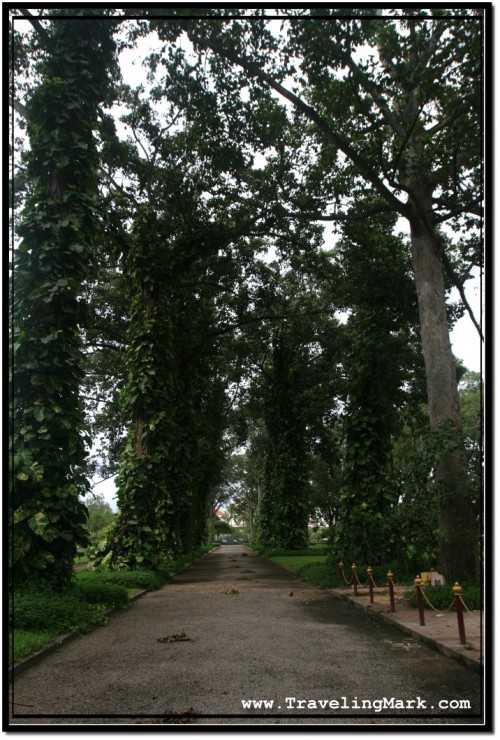Preah Khan is a large temple. After visiting Pre Rup, East Mebon, Ta Som and Neak Pean temple ruins, I was a bit spoiled because each of them was relatively small (not that small, but compared to most temples along the Petit Circuit, these were smaller) and didn’t take all that much time to explore. Coming to a temple that counted as one of the largest I have visited anywhere in Angkor yet, I had to mobilize much of my strength to still pull it off after 4 stops full of thorough explorations in this heat. It was already mid afternoon so the temperature were soaring, but the realization that I’m doing pretty good keeping up with schedule, and this is the last big task of the day, I was very eager to get right down to it.
Preah Khan was built during reign of Khmer king Jayavarman VII as a Buddhist monastery which also housed a centre of Buddhist studies. Finalized in 1191, Jayavarman VII dedicated the temple which was built on the site of his victory over the invading Chams to his father Dharanindra. Temple’s central sanctuary originally housed the statue of Lokesvara, the savior god of Mahayana Buddhism which was carved in the image of the king’s father. Unfortunately, this image, as well as all other images representing Buddhism were vandalized during the reign of king destroyer Jayavarman VIII who initiated the reform of Angkor’s religion in favor of Hinduism.
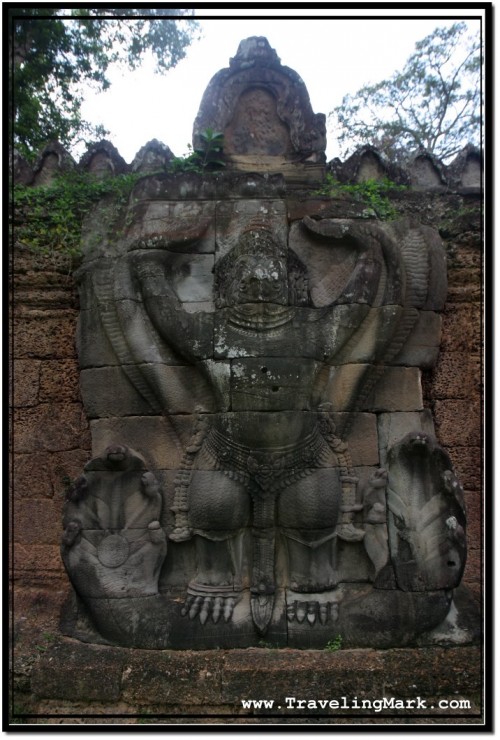
Being similar in layout and style to Ta Prohm (which Jayavarman VII dedicated to his mother), Preah Khan bears further similarities to the former in the many trees which grow among and over the ruins. I found Preah Khan to be the second most jungle overgrown in a huge-trees-intertwined-with-ancient-rock way temple – after Ta Prohm. That just about made it the second most photogenic temple as spots with those monster roots running down the crumbling walls like spilled honey were the most visually appealing feature of Angkor Archaeological Park that drew me to Cambodia in the first place.
Preah Khan, whose name means ‘sacred sword’ (derived from its original name of Nagara Jayasri – meaning holy city of victory) was built on an area covering 56 hectares (138 acres). Including the moat (now dry) which surrounds the outer enclosure, Preah Khan measures 800 x 700 meters. The Jayatataka Baray (huge artificial, rectangular shaped pond) which had the unusually round Neak Pean temple in its middle, was right to the east of Preah Khan. The temple is oriented to the east (as are all Buddhist temples) with eastern wall bearing the main gopura (entrance gate). Each of the exterior walls (each cardinal point) has its own gopura and each has its own causeway over the moat lined on both sides with (now headless) asuras and devatas carrying a body of a naga serpent – similar to what can be found at each entrance to Angkor Thom (best seen at the South Gate).
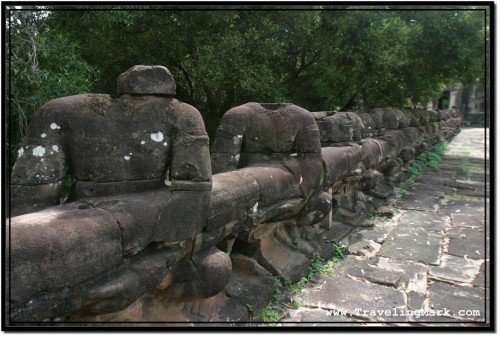
Preah Khan’s central sanctuary (now housing a Buddhist Stupa) is surrounded with four rectangular enclosures. Coming from the east (that’s where you will most likely come from), when you reach the second wall (third enclosure), you will have come to its, rather large gopura which has two huge silk trees growing over its southern side. One of the trees was leaning too much and threatened to take the entire structure down and had to be cut down. Its roots, which hold the coridor together, were however left in place (along with the other tree) and offer a fantastic opportunity for photography. Except that if you come in the afternoon, like I did, you will have the sun creating strong backlight, pretty much ruining what could have been an otherwise awesome picture. You can also take a picture from the opposite side of the wall and have a sun nicely illuminate it, but it doesn’t look nowhere as impressive from there.
Needless to say, the corridor over which the two giant trees grow is crumbled up and very unstable, presenting a very realistic danger of crushing down hence there are signs warning the visitors not to enter that spot. I had to be the one with the death wish and climbed over rubble to get in there for a picture from within the roots and even though nothing happened to me, I must strongly discourage anyone considering doing the same. If you decide to copy my reckless behavior and the weight of the trees delivers the wall its final blow, there will be no saving you. I could think of better ways to die than by being crushed by giant stones. Don’t do it!
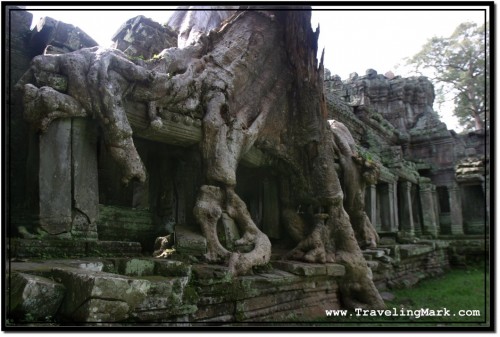
Further into the temple you would find another photogenic spot with what was once a huge tree growing over an ancient wall however the wall below that tree already did crumble down and only parts of it still stand supported by the roots and a wooden frame made by the restorers. The tree was too big and threatened further damage to the structure which sealed its demise. Only a stump is left of this once monster, however the stump is atop a big set of roots still encompassing much of the former wall in a composition that is sure to leave the viewer in awe.
Unfortunately, I only got a chance to go across the temple all the way to its western gopura (via the south which is flanked on both sides with cool stone guardians) and back before I started feeling uneasy about leaving my bike out of my sight while only locked against itself and went to repark it only to catch a group of greedy Cambodians attempting to steal it. This unpleasant experience had me abandon further exploration of Preah Khan and even though rather shaken, I moved on to the last few ruins on the Grand Circle.
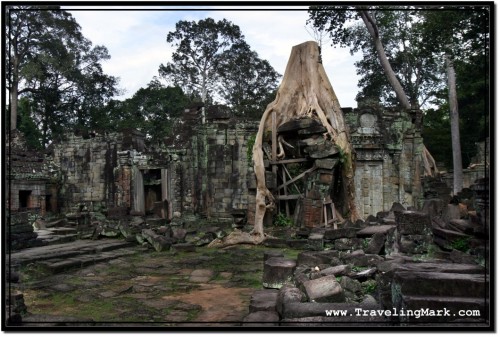
There is an exceptionally unique two storey high, stand alone building just north of the Hall of Dancers which is on the west side of the third gopura (second wall from the east to cross, aka the one with two trees growing over it). This unique building features round columns – something that’s not found anywhere else in Angkor. Because of the bicycle stealing episode, I did not go back to Preah Khan and as such, didn’t get a chance to take a picture of this unique building (and a bunch of others).
Overall, I did enjoy my time exploring Preah Khan – too bad a bunch of self righteous locals had to totally ruin the experience for me. Its location on the Grand Circuit makes Preah Khan a less attractive target which results in incomparably fewer visitors crossing its gates. If you’re an enthusiast, I’d say the temple is definitely worth the time and would reward the you with great photo opportunities. If you can time your visit for the morning, you’d also get good light for more captivating shots which would make the whole experience so much better.
More Photos of the Preah Khan Temple at Preah Khan Photo Gallery.
